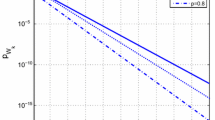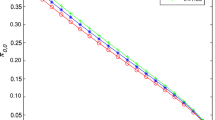Abstract
Queueing networks with blocking have broad applications in computer modelling and manufacturing. The present paper focusses on the MMAP[2]/M/1/ ∞ →·/M/1/K + 1 G-queue with blocking. This network consists of a sequence of two single-server stations with an infinite queue allowed before the first server and an intermediate queue of finite capacity K ≥ 0 allowed between servers. This restriction results in the blocking of the first server whenever a unit having completed its service in Station 1 cannot enter into Station 2 due to K + 1 units are accommodated into Station 2. There are two types of arrivals, called units and signals, which are modelled by a single Markovian arrival process with marked transitions. Each unit is served at Stations 1 and 2 in that order, and then it exits of the network. A signal induces the last unit in queue or in service, if there is one, to leave the network instantly, and it has no effect otherwise. Our purpose is to study the influence of the dependence between units and signals on the performance evaluation of the continuous-time Markov chain describing the state of the network at arbitrary times, which constitutes a quasi-birth-and-death process. We present tractable formulas for a variety of probabilistic descriptors, with special emphasis on the distribution of inter-departure times.
Similar content being viewed by others
References
Abate J, Whitt W (1995) Numerical inversion of Laplace transforms of probability distributions. ORSA J Comput 7:36–43
Akar N, Sohraby K (1997) Finite and infinite QBD chains: a simple and unifying algorithmic approach. In: Proceedings IEEE Infocom’97. IEEE Computer Society, Silver Spring, pp 1105–1113
Albores F, Bocharov P, Ilhuicatzi R, Lyubin D (2003) Analysis of a two-node exponential queueing network with blocking. In: Queues, flows, systems, networks. Proceedings of the international conference ‘modern mathematical methods of analysis and optimization of telecommunication networks’, Gomel, 23–25 September 2003, pp 11–17
Artalejo JR (2000) G-networks: a versatile approach for work removal in queueing networks. Eur J Oper Res 126:233–249
Asmussen S, Koole G (1993) Marked point processes as limits of Markovian arrival streams. J Appl Probab 30:365–372
Balsamo S (1994) Properties and analysis of queueing network models with finite capacities. In: Donatiello L, Nelson R (eds) Performance evaluation of computer and communication systems. Lecture notes in computer science, vol 729. Springer, Berlin Heidelberg New York
Balsamo S, de Nitto Personé V, Onvural R (2001) Analysis of queueing networks with blocking. Kluwer, Boston
Balsamo S, de Nitto Personé V, Inverardi P (2003) A review on queueing network models with finite capacity queues for software architectures performance prediction. Perform Eval 51:269–288
Bini DA, Meini B (1995) On cyclic reduction applied to a class of Toeplitz-like matrices arising in queueing models. In: Stewart WJ (ed) Computations with Markov chains. Kluwer, Boston, pp 21–38
Bini DA, Latouche G, Meini B (2005) Numerical methods for structured Markov chains. Oxford University Press, Oxford
Bocharov PP, Vishnevskii VM (2003) G-networks: development of the theory of multiplicative networks. Autom Remote Control 64:714–739
Bocharov PP, Viskova EV, Lyubin DYu (2005) The two-stage queueing system with negative arrivals in discrete time. In: Ermakov SM, Melas VB, Pepelyshev AN (eds) Proceedings of the fifth St. Petersburg workshop on simulation. NII Chemistry Saint Petersburg University Publishers, St. Petersburg, pp 155–161
Disney RL, Kiessler PC (1987) Traffic processes in queueing networks: a Markov renewal approach. Johns Hopkins University Press, Baltimore
Gelenbe E (1989) Random neural networks with negative and positive signals and product form solution. Neural Comput 1:502–510
Gelenbe E (1991) Product-form queueing networks with negative and positive customers. J Appl Probab 28:656–663
Gelenbe E (1994) G-networks: a unifying model for neural and queueing networks. Ann Oper Res 48:433–461
Golub GH, Van Loan CF (1996) Matrix computations. Johns Hopkins University Press, Baltimore
Gómez-Corral A (2002a) On a tandem G-network with blocking. Adv Appl Probab 34:626–661
Gómez-Corral A (2002b) A tandem queue with blocking and Markovian arrival process. Queueing Syst 41:343–370
Gómez-Corral A, Martos ME (2006) Performance of two-stage tandem queues with blocking: the impact of several flows of signals. Perform Eval 63:910–938
Grassmann WK, Drekic S (2000) An analytical solution for a tandem queue with blocking. Queueing Syst 36:221–235
Green D (2000) Lag correlations of approximating departure processes for MAP/PH/1 queues. In: Latouche G, Taylor PG (eds) Advances in algorithmic methods for stochastic models. Notable Publications, Neshanic Station, pp 135–151
Hall NG, Sriskandarajah C (1996) A survey of machine scheduling problems with blocking and no-wait in process. Oper Res 44:510–525
He QM (1996) Queues with marked customers. Adv Appl Probab 28:567–587
He QM (2000) Quasi-birth-and-death Markov processes with a tree structure and the MMAP[K]/PH[K]/N/LCFS non-preemptive queue. Eur J Oper Res 120:641–656
He QM (2001) The versatility of MMAP[K] and the MMAP[K]/G[K]/1 queue. Queueing Syst 38:397–418
He QM (2004) Workload process, waiting times, and sojourn times in a discrete time MMAP[K]/SM[K]/1/FCFS queue. Stoch Models 20:415–437
He QM, Li H (2003) Stability conditions of the MMAP[K]/G[K]/1/LCFS preemptive repeat queue. Queueing Syst 44:137–160
He QM, Neuts MF (1998) Markov chains with marked transitions. Stoch Process Their Appl 74:37–52
Heindl A (2001) Decomposition of general tandem queueing networks with MMPP input. Perform Eval 44:5–23
Heindl A (2003) Decomposition of general queueing networks with MMPP inputs and customer losses. Perform Eval 51:117–136
Hunter JJ (1983) Mathematical techniques of applied probability, vol 1. Discrete time models: basic theory. Academic, New York
Klimenok VI, Breuer L, Tsarenkov G, Dudin AN (2005) The \(BMAP/G/1/\bar{N}\to\cdot /PH/1/M\) tandem queue with losses. Perform Eval 61:17–40
Konheim AG, Reiser M (1976) A queueing model with finite waiting room and blocking. J Assoc Comput Mach 23:328–341
Konheim AG, Reiser M (1978) Finite capacity queuing systems with applications in computer modeling. SIAM J Comput 7:210–229
Latouche G, Neuts MF (1980) Efficient algorithmic solutions to exponential tandem queues with blocking. SIAM J Algebr Discrete Methods 1:93–106
Latouche G, Ramaswami V (1993) A logarithmic reduction algorithm for quasi birth and death processes. J Appl Probab 30:650–674
Latouche G, Ramaswami V (1999) Introduction to matrix analytic methods in stochastic modeling. ASA-SIAM, Philadelphia
Lucantoni DM, Meier-Hellstern KS, Neuts MF (1990) A single-server queue with server vacations and a class of non-renewal arrival processes. Adv Appl Probab 22:676–705
Naoumov V, Krieger UR, Wagner D (1996) Analysis of a multiserver delay-loss system with a general Markovian arrival process. In: Chakravarthy SR, Alfa AS (eds) Matrix-analytic methods in stochastic models. Lecture notes in pure and applied mathematics, vol 183. Marcel Dekker, New York, pp 43–66
Neuts MF (1994) Matrix-geometric solutions in stochastic models: an algorithmic approach, 2nd edn. Dover, New York
Neuts MF, Li JM (2000) The input/output process of a queue. Appl Stoch Models Bus Ind 16:11–21
Onvural RO (1990) Survey of closed queueing networks with blocking. ACM Comput Surv 22:83–121
Ost A (2001) Performance of communication systems. A model-based approach with matrix-geometric methods. Springer, Berlin
Park D, Perros HG, Yamashita H (1994) Approximate analysis of discrete-time tandem queueing networks with bursty and correlated input traffic and customer loss. Oper Res Lett 15:95–104
Perros HG (1989a) A bibliography of papers on queueing networks with finite capacity queues. Perform Eval 10:255–260
Perros HG (1989b) Open queueing networks with blocking. In: Takagi H (ed) Stochastic analysis of computer and communication systems. North-Holland, Amsterdam
Perros HG (1994) Queueing networks with blocking. Exact and approximate solutions. Oxford University Press, New York
Shin YW, Choi BD (2003) A queue with positive and negative arrivals governed by a Markov chain. Probab Eng Inf Sci 17:487–501
Shin YW (2004) Multi-server retrial queue with negative customers and disasters. In: Choi BD (ed) Proceedings of the fifth international workshop on retrial queues. TMRC - Korea University, Seoul, pp 53–60
Author information
Authors and Affiliations
Corresponding author
Rights and permissions
About this article
Cite this article
Gómez-Corral, A., Martos, M.E. Marked Markovian Arrivals in a Tandem G-Network with Blocking. Methodol Comput Appl Probab 11, 621–649 (2009). https://doi.org/10.1007/s11009-008-9080-8
Received:
Revised:
Accepted:
Published:
Issue Date:
DOI: https://doi.org/10.1007/s11009-008-9080-8




